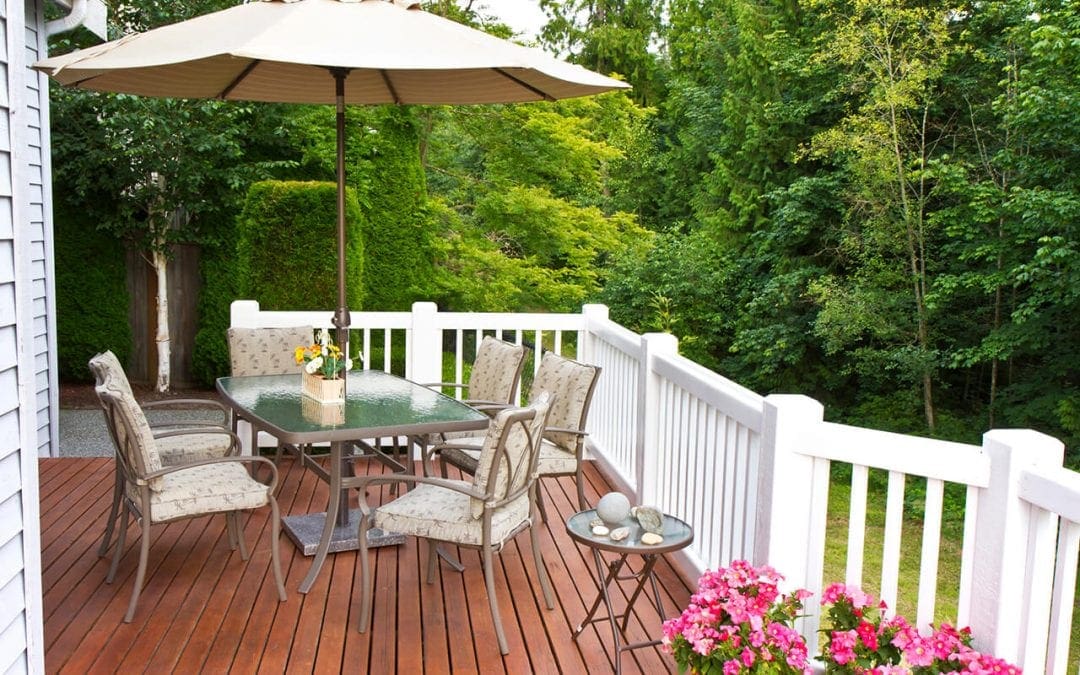There are pros and cons of different decking materials. So, before choosing a certain type of deck, compare the benefits and drawbacks. This way, you can decide which type of deck is right for you.
Different Types of Decking Materials
Here are the pros and cons of 5 of the different types of decking materials:
Composite
This decking material was introduced in the 1990s, and it has consistently increased in popularity. Composite materials usually mimic real wood.
Pros: Composite decks don’t require periodic maintenance like wood decks. Composite materials have a combination of wood fibers and plastic.
Cons: Composite materials are generally much more expensive than pressure-treated lumber, costing approximately 2.5 times more. They can grow mildew on them and should be washed regularly.
Tropical Hardwoods
Tropical hardwoods are a luxury decking option that has a lot of benefits. If you can afford a tropical hardwood deck, you will appreciate its beauty and durability.
Pros: Once you build a deck out of tropical hardwoods, it should last you a long time. It can last anywhere from 25-75 years, depending on the species of wood. Tropical hardwoods are also known for their rich colors.
Cons: Tropical hardwoods, like mahogany and teak, can be very costly. They can cost up to four to five times as pressure-treated pine. Even though they are quite durable, it is difficult to drive nails and screws into them and the lumber is heavy. Because of this, labor costs are high and they are hard to repair. You also have to periodically reapply a sealant if you don’t want the color to turn grey.
Natural Softwoods
Natural softwoods, like cedar and redwood, are popular decking materials. These woods have natural oils that make them resistant to insect infestation and rot. No pressure treatment is needed.
Pros: Many homeowners choose to build a deck from natural softwood because of the rustic beauty. Redwood and cedar are less expensive in areas that harvest those types of wood. On the other hand, these types of wood can cost twice as much as pressure-treated pine.
Cons: Natural softwoods require maintenance to protect them from fading. They are also not fire-resistant.
Pressure-Treated Pine
The majority of decks are made from pressure-treated pine. This is because it is the most affordable option.
Pros: Pressure-treated pine is chemically treated to help it resist water and insect damage. If you are budget-minded but want to create a new outdoor living space, this may be your best option.
Cons: You’re going to need to perform maintenance tasks on a pressure-treated deck once a year to keep it in good shape, which makes this material more high maintenance than some other decking materials. When well-maintained, a pressure-treated deck will last an average of 15 to 20 years.
Aluminum Decking Materials
Aluminum is a great choice for certain styles of homes. The industrial look won’t look right on an older home but works well on a modern design.
Pros: Aluminum can’t be damaged by insects, mildew, rot, or fire. It doesn’t crack or warp, and it’s very durable and lightweight.
Cons: This is the most expensive kind of decking material. It can be slippery when wet and loud when walked on, which is why some people decide against it.
If you are building a new deck or replacing a deck, compare your options for decking materials.
Five Stars Home Inspection provides inspection services to Boston and the surrounding areas. Contact us to schedule an appointment.

